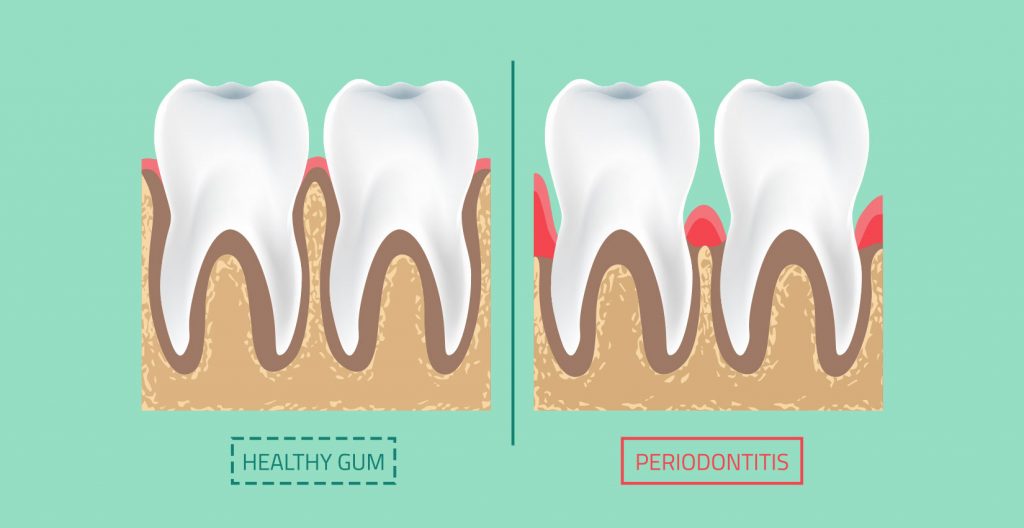While gum disease (Periodontal disease) is quite common (almost half of all American adults have it), it can be tricky to notice before it is too late. Gum disease is a serious infection that occurs in the gum tissue. This infection forms when there is an unchecked amount of harmful bacteria above and below the gum line that can lead to severe health and dental complications. This article outlines some common red flags to help you stay aware of the problem before it is too late.
Bad Breath
The medical term for constant bad breath is halitosis. Bad breath is one of the tell-tale signs that commonly come with gum disease.
When food particles and bacteria linger inside the mouth, they release unpleasant odors. Bad breath is not just a warning sign of gum disease but can be a large source of embarrassment for many people and affect one’s quality of life. If you are constantly battling bad breath that doesn’t go away, even after brushing and flossing, this may be a sign of gum disease. According to a study published in the Journal of the International Society of Preventative and Community Dentistry, 80% of all gum disease patients have bad breath.
Loose Teeth and Tooth Loss
Bacteria, plaque, and tartar buildup will irritate gums and starts to break down the healthy bone tissue that holds teeth in place. As the bone recedes, the tooth becomes loose, as it no longer has healthy bone tissue closely surrounding it and holding it firmly in place.
If this is allowed to continue without seeking professional treatment, the bone will continue to wear away until the tooth is extremely loose and at serious risk of falling out. In this case, there are several treatment options, such as dentures, dental implants, or dental bridges. It is always best to take care of this issue before natural teeth are lost.
Receding Gums
Gum recession is when the tissues surrounding your teeth pull back near the root and expose more of your teeth. Gum recession makes your teeth look longer than usual. The wearing away of the gum tissues also leaves “pockets” or gaps between individual teeth, and these spaces can trap food particles and cause bacteria buildup. If left untreated, receding gums can eventually lead to tooth loss.
Pain, Swelling, and Bleeding in the Gums
Red, swollen gums that bleed easily is another sign of periodontal diseases. When these symptoms first appear, they are likely to be the first stage of gum disease or gingivitis. The bacteria from plaque buildup can irritate the gums, causing inflammation. If you do not treat gingivitis, it can lead to other dental problems, such as periodontitis and tooth loss.
The good news is gingivitis can be reversed with proper treatment and oral care. But if
Swelling in the gums can also be caused by pregnancy, tooth decay, or fungal infection. Visit your dentist to find out the cause of the swelling.
Tooth Sensitivity
Tooth sensitivity is discomfort in your tooth trigged by eating or drinking something hot, cold, sweet, salty, or even by breathing cold air.
One of the reasons tooth sensitivity happens is because of gum disease. Teeth sensitivity caused by gum disease can happen in two ways: first, when gingivitis inflames the gums, the swollen gums become very sensitive to temperature and pressure. Second, when periodontal diseases cause gum recession and leave the roots exposed. As a result, the teeth become extremely sensitive to even the slightest touch.
Other factors can also cause sensitive teeth, such as a cavity, a cracked or chipped tooth, or a worn filling. Visit your dentist to find out the cause of you sensitive teeth.
Common causes of gum disease include:
- Poor oral hygiene
- Failure to attend professional cleaning appointments
- Tobacco use
- Fillings that have become defective
- Prescription medications
- Genetic predisposition
- Untreated gingivitis
- Hormonal changes
- Side effects of HIV, cancer, or diabetes
How To Prevent Gum Disease
When it comes to your oral health, prevention is key.
- Good oral hygiene. Brushing and flossing twice every day removes the bacteria that cause gum disease. Flossing before you brush allows you to clean away the loosened food particles and bacteria.
- Regular dental visits and Cleanings. See your dentist or dental hygienist every 6 to 12 months for cleanings and checkups. Dental cleanings are one of the most important treatments for preventing gum disease.
Thankfully, during your professional dental cleaning, your hygienist will ensure that all surfaces of the teeth are thoroughly cleaned – especially in the rear section of the mouth, where it is easy to miss a spot or two potentially.
What’s Next?
If you have experienced any of the gum disease symptoms we discussed, it is important not to ignore them or hope they will go away. Be sure to tell your dentist right away so you can get the treatment you need to maintain a healthy oral environment.
Periodontal Disease Treatment in South Gate, CA
Feel free to give us a call to schedule an appointment. We are here to help you maintain a healthy and beautiful smile.

 Available For Emergencies
Available For Emergencies